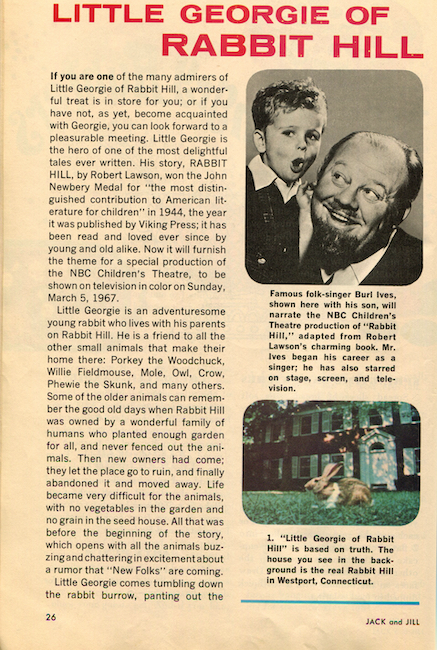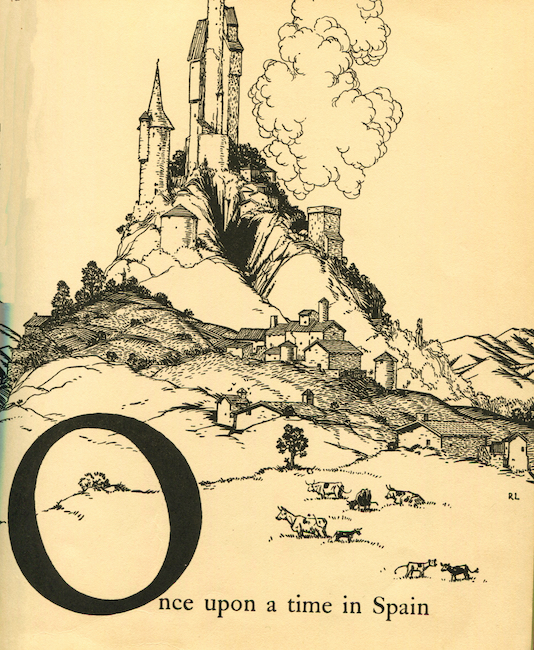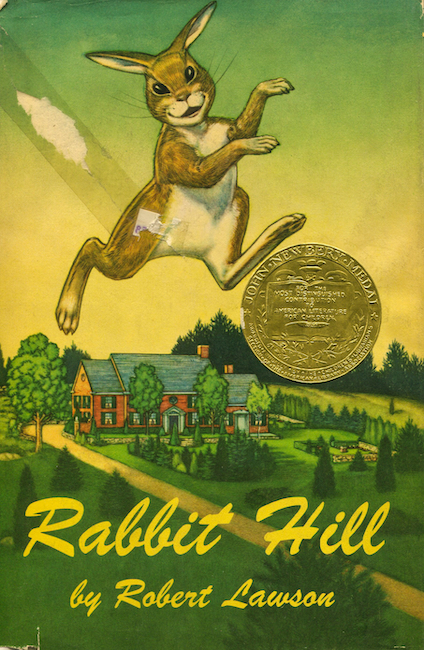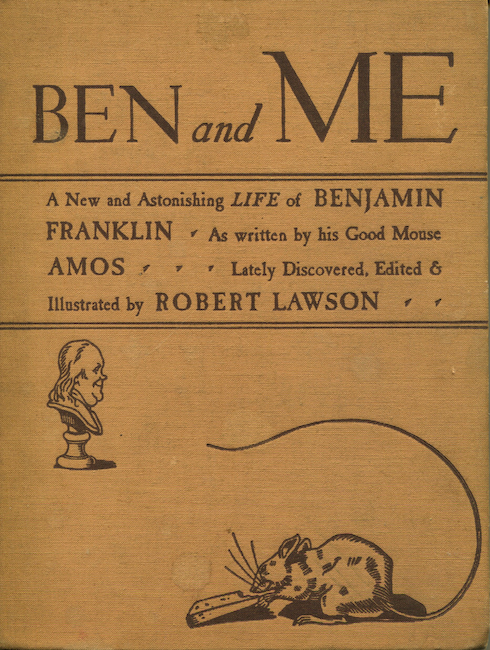In my office, I have an odd calendar: an old child’s wagon with a stack of vintage Jack and Jill magazines. At the beginning of each month, I pull out the corresponding month’s issue. In March, I chose March 1967, which featured the TV Preview of “Little Georgie of Rabbit Hill.”
NBC Children’s Theater aired an adaptation of Robert Lawson’s Rabbit Hill.

It’s on YouTube, in two parts. The program features footage of live animals— rabbits, raccoons, mice, deer, a skunk — spliced to create the story, partly filmed at Lawson’s real Rabbit Hill house, with Burl Ives’ buttery narration.
Born in New York City in 1892, Lawson entered a high school poster contest with his very first drawing and won. The early twentieth century is known as the Golden Age of Illustration, with such luminaries as Arthur Rackham, Maxfield Parrish, Jessie Willcox Smith, and Kay Nielsen. Robert Lawson’s career blossomed in their spotlight as he rendered fairies, gnomes, and sprites. His style became more realistic when he shifted into children’s books. He and his wife moved to Connecticut and built a house they called Rabbit Hill.

illustrated by Robert Lawson, published by Viking Books for Young Readers in 1936 and still in print.
Lawson’s illustrations added humor and humility to stories like Ferdinand and Mr. Popper’s Penguins. It was in his own Rabbit Hill that I once traced each blade of grass and Little Georgie’s loppy rabbit ears. Is there anything finer than a middle grade book with interior art? Yes, a middle grade book about woodland animals with excellent interior art. Robert Lawson’s linework is certain, his vision reflecting “the clear eyes of childhood.” In his detailed art, he wanted to give readers “everything I know or can think of and let them do the choosing.”

Rabbit Hill won the Newbery Medal in 1945 (earlier, he’d earned a Caldecott). In his acceptance speech, Lawson admitted that in previous books, he outlined up to the last sentence, but with this book, he “merely pushed the pencil and pecked at the typewriter … once it was begun, it just went ahead and wrote itself.” His animal characters seamlessly blend fantasy and realism. You believe in them because they are real animals.
The sequel The Tough Winter was published to more rave reviews, including The New York Times: “There is gentle humor in the book’s sensitive, beautiful drawings. The prose reflects a love of nature and respect for all small beings.” I believed in those talking animals with my whole heart. Rabbits and raccoons don’t just skulk around yards and gardens. They have lineage and backstories and set a great store by human manners and behavior.
Robert Lawson also combined history with animals in books like Ben and Me, with a mouse telling Benjamin Franklin’s story, followed by Captain Kidd’s Cat, I Discover Columbus (parrot narrator), and Mr. Revere and I (the horse, of course). In each of these, the animal companions are largely responsible for the historical person’s success.

In 1940, Lawson wrote an article for The Horn Book, entitled “The Genius of Arthur Rackham.”
It begins: “Arthur Rackham had died and I never knew it.” By 1940, the Golden Age illustrators were largely forgotten. Lawson was critical of the current style of “distorted figures and a sign-painter’s technique,” and admitted he and others had tried unsuccessfully to imitate Rackham, an impossible task. Lawson wrote, “I have never known Rackham to drop below the level of mastery by so much as a single line. To study his work … is a revelation in skill and courage.”
Lawson was sorry he didn’t know when his idol had passed. “It must have happened that evening when the rabbits acted so strangely … In the twilight the rabbits came, more rabbits than we had ever known at one time … Later we heard a fox bark and saw the vague shadows of deer. There were tiny rustlings in the grass and we felt that somewhere, Something had happened.”
The same could be said of Robert Lawson when he left this world in 1957. I didn’t watch much of the TV special, preferring to reexperience the skill and courage of Rabbit Hill through his words and pictures.
